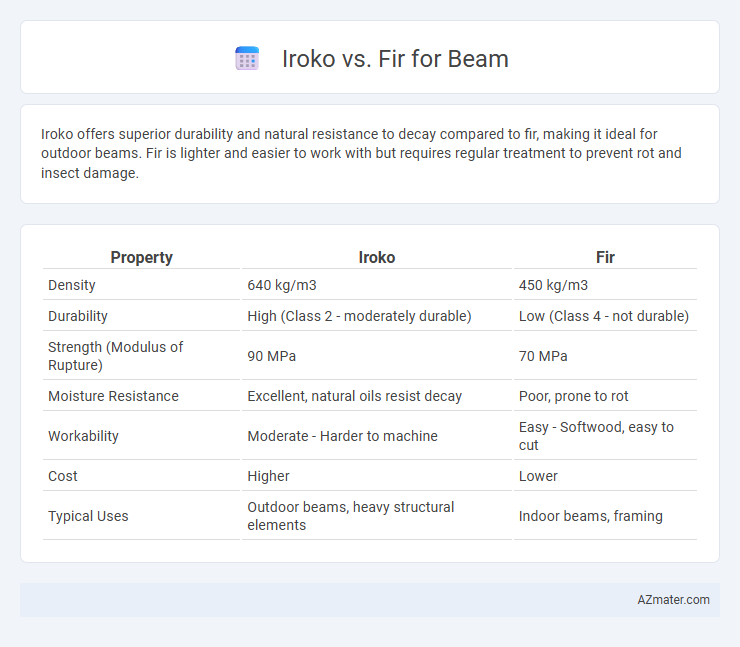Iroko offers superior durability and natural resistance to decay compared to fir, making it ideal for outdoor beams. Fir is lighter and easier to work with but requires regular treatment to prevent rot and insect damage.
Table of Comparison
| Property | Iroko | Fir |
|---|---|---|
| Density | 640 kg/m3 | 450 kg/m3 |
| Durability | High (Class 2 - moderately durable) | Low (Class 4 - not durable) |
| Strength (Modulus of Rupture) | 90 MPa | 70 MPa |
| Moisture Resistance | Excellent, natural oils resist decay | Poor, prone to rot |
| Workability | Moderate - Harder to machine | Easy - Softwood, easy to cut |
| Cost | Higher | Lower |
| Typical Uses | Outdoor beams, heavy structural elements | Indoor beams, framing |
Introduction to Iroko and Fir as Beam Materials
Iroko and Fir are popular hardwood and softwood choices for beams, valued for their strength and durability in construction. Iroko, a dense African hardwood, offers excellent resistance to rot and insects, making it ideal for outdoor and structural applications. Fir, a softwood known for its straight grain and lightweight nature, provides ease of handling and cost-effectiveness while maintaining good load-bearing capacity in beam construction.
Botanical and Origin Differences
Iroko (Milicia excelsa) is a hardwood species native to Central and West Africa, known for its durability and yellow-brown color, while Fir (genus Abies) is a softwood commonly found in the Northern Hemisphere, particularly in North America and Europe, characterized by lighter color and straight grain. Iroko trees grow predominantly in tropical rainforest climates, producing dense, oily wood resistant to decay and insect attacks, whereas Fir thrives in cooler temperate zones, offering a lighter, less dense wood that is easier to work with but less naturally resistant. These botanical and geographic distinctions influence their use in beam construction, with Iroko favored for heavy-duty, outdoor applications and Fir chosen for interior framing where flexibility and cost-efficiency are prioritized.
Mechanical Strength Comparison
Iroko wood offers superior mechanical strength compared to Fir, with higher density and hardness making it ideal for load-bearing beams. Iroko's bending strength typically ranges around 80-90 MPa, surpassing Fir's average of 55-65 MPa, which translates to better resistance against deformation and higher structural integrity. This increased strength makes Iroko more durable for heavy-duty construction where beam performance is critical.
Durability and Resistance to Decay
Iroko wood offers superior durability and exceptional resistance to decay compared to fir, making it ideal for outdoor beam applications where longevity is critical. Iroko's natural oils provide high resistance to moisture, fungi, and insect attacks, whereas fir requires chemical treatments to achieve comparable protection. While fir is lighter and easier to work with, its lower natural durability reduces its lifespan in exposure to harsh environmental conditions.
Workability and Ease of Installation
Iroko offers superior workability compared to Fir due to its dense grain and resistance to splitting, making it ideal for precise beam applications. Fir is lighter and softer, allowing for easier cutting and nailing, which simplifies installation but may require additional treatment for durability. Iroko's natural resistance to decay also reduces maintenance post-installation, enhancing its long-term performance in structural beams.
Aesthetic Appeal and Grain Patterns
Iroko wood offers a rich, golden to medium brown hue with interlocking grain patterns that create a striking visual texture, making it a popular choice for beams where warmth and natural beauty are desired. Fir, on the other hand, tends to have a lighter, pale yellow to reddish-brown color with straight, uniform grain patterns that provide a cleaner and more minimalist aesthetic. The choice between Iroko and Fir for beams significantly impacts the overall look, with Iroko delivering a distinctive, robust grain and darker tone, while Fir offers subtle elegance and consistent grain structure.
Environmental Impact and Sustainability
Iroko wood, known for its durability and natural resistance to decay, is sourced from West African forests but faces sustainability concerns due to overharvesting and slower growth rates compared to Fir. Fir, a fast-growing softwood primarily harvested from managed forests in North America and Europe, offers a more sustainable option with a lower environmental footprint thanks to efficient replanting and carbon sequestration practices. When considering environmental impact, Fir beams typically result in reduced deforestation pressures and better carbon lifecycle balance, while Iroko provides longevity that may reduce frequency of replacement.
Cost Analysis: Iroko vs Fir
Iroko beams typically cost significantly more than fir beams due to their dense hardwood properties and durability, with prices averaging $25 to $40 per board foot compared to fir's $10 to $15 per board foot. Fir, a softwood, offers a budget-friendly alternative while maintaining adequate strength for most structural applications, making it ideal for cost-sensitive projects. While Iroko provides longer lifespan and resistance to rot and insects, the initial investment is higher, which can impact overall project budgets.
Suitability for Indoor and Outdoor Applications
Iroko, with its natural resistance to moisture and decay, is highly suitable for outdoor beams exposed to weather elements, providing durability and stability over time. Fir, favored for indoor beams, offers a straight grain and uniform texture, making it ideal for interior structural use where it is protected from moisture. Both woods are strong, but Iroko's dense fibers and natural oils give it a superior performance in exterior applications compared to fir's more moderate indoor suitability.
Conclusion: Choosing the Right Timber for Beams
Iroko offers exceptional durability and resistance to decay, making it ideal for outdoor beams exposed to harsh weather conditions. Fir provides excellent structural strength and a lighter weight, making it suitable for indoor beams requiring ease of handling and cost efficiency. Selecting the right timber depends on the project's environmental demands and budget constraints, with Iroko preferred for longevity and Fir for economic practicality.

Infographic: Iroko vs Fir for Beam
 azmater.com
azmater.com